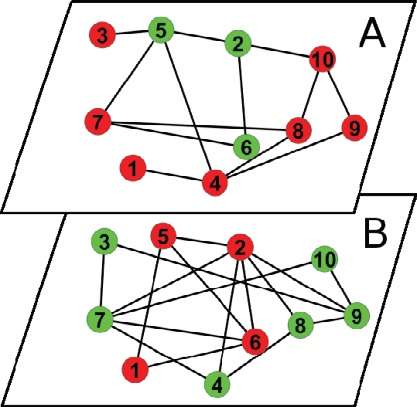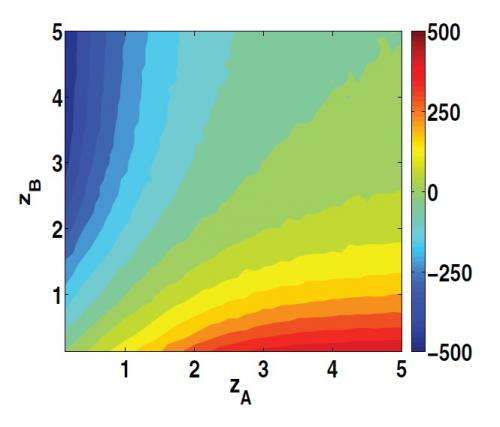April 26, 2013 feature
To win an election, a strongly connected voter network is key, physicists conclude

(Phys.org) —The results of a new study support what many people intuitively know about winning political elections: the party that has a more connected voter network usually receives more votes. However, the study also found that, if the less connected network has even a small fraction of strongly committed voters, these voters have the ability to reverse the election outcome. The study demonstrates how multiple interacting and interdependent networks can be used to model and gain insight into real-world political elections, with the potential to influence future campaign strategies.
The researchers, Arda Halu, et al., have published their study on using interacting networks to address political elections in a recent issue of EPL (Europhysics Letters).
"The greatest novelty in our work is the idea to model a party as a network, and consequently the election process as a competition between two interacting networks," coauthor Ginestra Bianconi at Queen Mary University of London told Phys.org. "The result that we get is mostly intuitive: the most connected party gets the majority of the votes at the end of the election campaign, but to our knowledge this is the first time such intuition has been formalized in a framework of a scientific model."
In their deliberately simple model, the researchers built two networks, each of which represents a different political party. Individual voters, or agents, are represented in both networks by a node. However, voters can be active (i.e., vote) in only one party/network, or they can choose not to vote at all.
To begin the simulation, the researchers started from an initial condition where the active nodes in both networks are distributed uniformly. The agents are influenced by their neighbors, so that an agent who is not already active in Network A will be active in Network B if at least one of its neighbors is active in Network B.
To run the simulation, a node is chosen randomly in either one of the networks and is changed from active to inactive or vice versa. If this change decreases the number of conflicts between itself and its neighbors (i.e., the neighbors support the same party as the randomly chosen node), then the change is accepted. If the change increases the number of conflicts, then it is accepted with a certain probability.
This process is repeated, but the probability with which a conflict-increasing change is accepted decreases. In other words, fewer conflicts are tolerated as time goes on because agents tend to stick to their decision more as election day approaches. The researchers modeled this conflict reduction by decreasing the "temperature" of the system, where a high temperature corresponds to many conflicts and a low temperature corresponds to few conflicts.
At the end of the simulation, on election day, the researchers counted the votes and found that the more connected party/network usually has the majority of the votes. This outcome does not depend on the initial conditions, but holds for any initial condition with randomly distributed active nodes.

In real life, many individuals decide which party to vote for in the beginning and never change their minds, regardless of their neighbors' influences. These individuals are known as committed agents, and previous research has shown that these committed minorities play a crucial role in different aspects of social dynamics. In this study, the researchers found that when a fraction of the nodes in the less connected network never change their opinion, they can potentially reverse the outcome of the election. In this case, the less connected party can win.
"The results of our paper show also that if the competing parties are both well connected, then a small percentage (around 10%) of committed agents can reverse the outcome of the election," Bianconi said. "This result is in line with other recent works on opinion dynamics for other types of opinion processes."
In the future, the researchers plan to extend this model in various ways, such as to describe three or more competing parties, to allow agents to express multiple preferences in a multi-layered opinion space, and to change agents' opinions in different ways. Research in these areas could provide insight into the opinion formation processes in many different real-world contexts besides political elections.
"Most of the real-world networks are part of a system of interacting networks that coexist, interact and co-evolve," Bianconi said. "Examples include multimodal transportation networks, climatic systems, economic markets, energy-supply networks and the human brain. Moreover, many networks are multiplex, indicating the fact that each pair of node can interact with each other by means of different kinds of relationships. This is the case of social networks in which agents can be bound, at the same time, by familiar relationships, friendship, professional collaboration, co-location, etc.
"Until now, the scientific community has only focused on interdependencies between networks, but in real-world situations, different networks might also be competing, as it happens for the major two parties during the election campaign. What we have explored so far is the first example of a model in which interacting networks are competing. In infrastructures systems, or in economic markets, we might have similar situations in which the functionality, or activity, of a node in a network is incompatible with the functionality of another node in the interacting network. These competing interactions between different nodes in interacting networks sometimes might coexist with interdependencies. In order to answer questions about the robustness, and the dynamics of the complex world around us, we believe that it is crucial to investigate interacting networks and the large varieties of types of interactions between them."
The researchers also plan to incorporate more complexity into these network models in the future.
"Despite the fantastic advances obtained in the last ten years in the understanding of complexity and networked systems, we are still not able to describe, predict and control the dynamics of a large variety of complex systems, from weather networks, to the society and the brain," Bianconi said. "The reason is that many systems are not formed by isolated networks; instead, they are formed by a network of networks eventually changing over time. Therefore for us, scientists working in statistical mechanics, it is now possible—in a sense it is mandatory—to move into the field to find and to shed light on the complexity on interdependent and time-varying networks. Without new statistical mechanics frameworks, the field will have little hope to advance in the understanding of collective phenomena occurring in these networks. Therefore our plan for the future is to develop new theoretical statistical mechanics methods for interacting and temporal networks. The hope is to find new theoretical frameworks to describe, predict and control temporal and interdependent complex systems."
More information: Arda Halu, et al. "Connect and win: The role of social networks in political elections." EPL, 102 (2013) 16002. DOI: 10.1209/0295-5075/102/16002
Journal information: Europhysics Letters (EPL)
Copyright 2013 Phys.org
All rights reserved. This material may not be published, broadcast, rewritten or redistributed in whole or part without the express written permission of Phys.org.



















